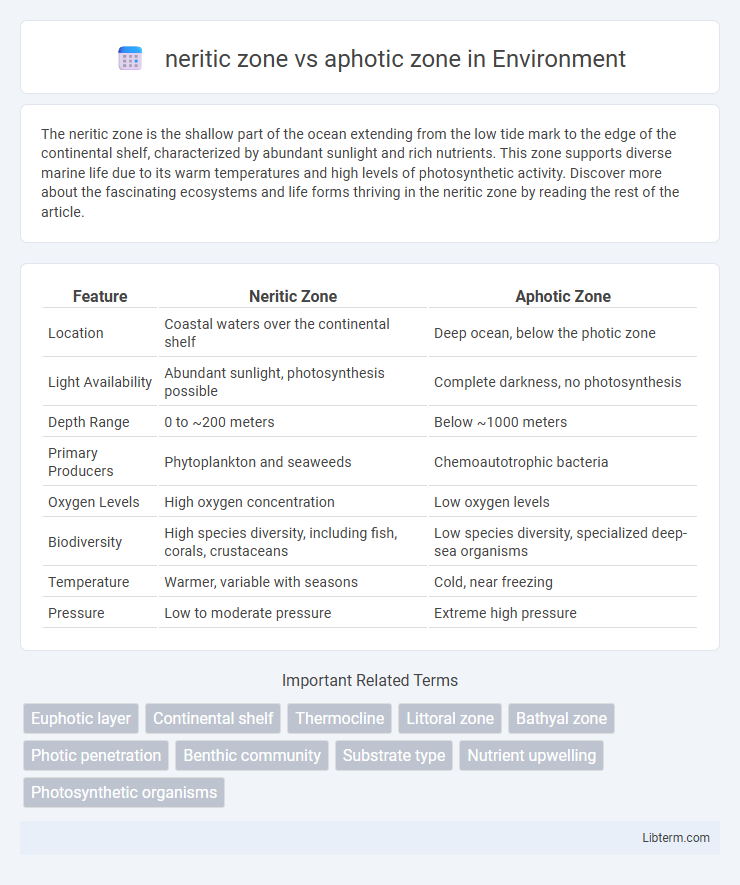The neritic zone is the shallow part of the ocean extending from the low tide mark to the edge of the continental shelf, characterized by abundant sunlight and rich nutrients. This zone supports diverse marine life due to its warm temperatures and high levels of photosynthetic activity. Discover more about the fascinating ecosystems and life forms thriving in the neritic zone by reading the rest of the article.
Table of Comparison
| Feature | Neritic Zone | Aphotic Zone |
|---|---|---|
| Location | Coastal waters over the continental shelf | Deep ocean, below the photic zone |
| Light Availability | Abundant sunlight, photosynthesis possible | Complete darkness, no photosynthesis |
| Depth Range | 0 to ~200 meters | Below ~1000 meters |
| Primary Producers | Phytoplankton and seaweeds | Chemoautotrophic bacteria |
| Oxygen Levels | High oxygen concentration | Low oxygen levels |
| Biodiversity | High species diversity, including fish, corals, crustaceans | Low species diversity, specialized deep-sea organisms |
| Temperature | Warmer, variable with seasons | Cold, near freezing |
| Pressure | Low to moderate pressure | Extreme high pressure |
Introduction to Oceanic Zones
The neritic zone extends from the low tide mark to the edge of the continental shelf, characterized by abundant sunlight penetration that supports diverse marine life and photosynthetic organisms. In contrast, the aphotic zone lies beneath the photic zone at depths typically below 200 meters, where sunlight is insufficient for photosynthesis, resulting in a cold, dark environment with specialized fauna adapted to high pressure and low light conditions. These oceanic zones define key ecological boundaries that influence biodiversity, nutrient cycles, and primary productivity in marine ecosystems.
Defining the Neritic Zone
The neritic zone is the shallow part of the ocean extending from the low tide mark to the edge of the continental shelf, typically up to 200 meters deep, where sunlight penetrates and supports high primary productivity. This zone contrasts with the aphotic zone, which lies below the photic depth and receives little to no sunlight, limiting photosynthesis and resulting in a different ecological environment. Rich biodiversity and abundant marine life characterize the neritic zone, making it crucial for fisheries and coastal ecosystems.
Understanding the Aphotic Zone
The aphotic zone, located below the neritic zone, receives no sunlight, preventing photosynthesis and supporting primarily heterotrophic organisms. This deep-sea environment is characterized by high pressure, low temperatures, and limited food sources, making it a challenging habitat for marine life. Adaptations such as bioluminescence and chemosynthesis are common among species inhabiting the aphotic zone, which contrasts with the sunlit, productive neritic zone.
Light Availability Comparison
The neritic zone receives abundant sunlight due to its shallow depth, supporting photosynthetic organisms such as phytoplankton and coral reefs. In contrast, the aphotic zone lies below the reach of sunlight, typically deeper than 200 meters, where light penetration is minimal or nonexistent, inhibiting photosynthesis. This stark contrast in light availability drives distinct biological communities and energy dynamics in each marine zone.
Temperature and Depth Differences
The neritic zone extends from the low tide mark to the edge of the continental shelf, typically reaching depths of up to 200 meters, where sunlight penetrates, maintaining relatively warm temperatures around 20-25degC. In contrast, the aphotic zone begins at depths beyond 200 meters, extending down to the ocean's abyss, characterized by complete darkness and significantly colder temperatures often dropping below 4degC. These temperature and depth differences critically influence marine biodiversity and biological processes within each zone.
Biodiversity and Marine Life
The neritic zone, extending from the low tide mark to the edge of the continental shelf, supports high biodiversity with abundant sunlight enabling photosynthesis and thriving marine life such as coral reefs, fish, and plankton. In contrast, the aphotic zone lies below 200 meters where sunlight is absent, resulting in limited photosynthetic organisms and specialized fauna like bioluminescent fish, deep-sea cephalopods, and scavengers adapted to high pressure and low temperatures. This stark difference in light availability drives the complexity and diversity of ecosystems between the sunlit neritic zone and the dark, nutrient-scarce aphotic zone.
Ecosystem Productivity
The neritic zone exhibits high ecosystem productivity due to abundant sunlight penetration, supporting prolific photosynthesis by phytoplankton and extensive marine life diversity. In contrast, the aphotic zone experiences minimal biological productivity as sunlight does not reach these depths, limiting photosynthetic organisms and relying mainly on organic matter falling from upper layers. Nutrient recycling and chemosynthetic processes partially sustain the aphotic ecosystem but result in significantly lower overall productivity compared to the neritic zone.
Adaptations of Organisms
Organisms in the neritic zone exhibit adaptations such as bright pigmentation and streamlined bodies to thrive in well-lit, nutrient-rich waters with abundant plant life. In contrast, species in the aphotic zone have evolved bioluminescence, enhanced sensory organs, and slow metabolisms to survive in complete darkness and high pressure. These adaptations reflect evolutionary responses to the distinct environmental conditions of shallow, sunlit waters versus deep, lightless ocean depths.
Human Impact on Each Zone
Human activities such as coastal development, pollution, and overfishing primarily threaten the neritic zone, leading to habitat loss and declining fish populations. In contrast, the aphotic zone faces fewer direct human impacts but is increasingly affected by deep-sea mining, plastic pollution, and climate change-induced alterations in ocean chemistry. Conservation efforts targeting both zones must address these specific challenges to preserve marine biodiversity and ecosystem services.
Summary of Key Differences
The neritic zone is the shallow part of the ocean extending from the low tide mark to the edge of the continental shelf, characterized by abundant sunlight, high nutrient levels, and diverse marine life. In contrast, the aphotic zone lies below the reach of sunlight, typically deeper than 200 meters, where photosynthesis is impossible and organisms rely on detritus or chemosynthesis for energy. Key differences include light availability, depth range, biodiversity, and primary energy sources.
neritic zone Infographic

 libterm.com
libterm.com